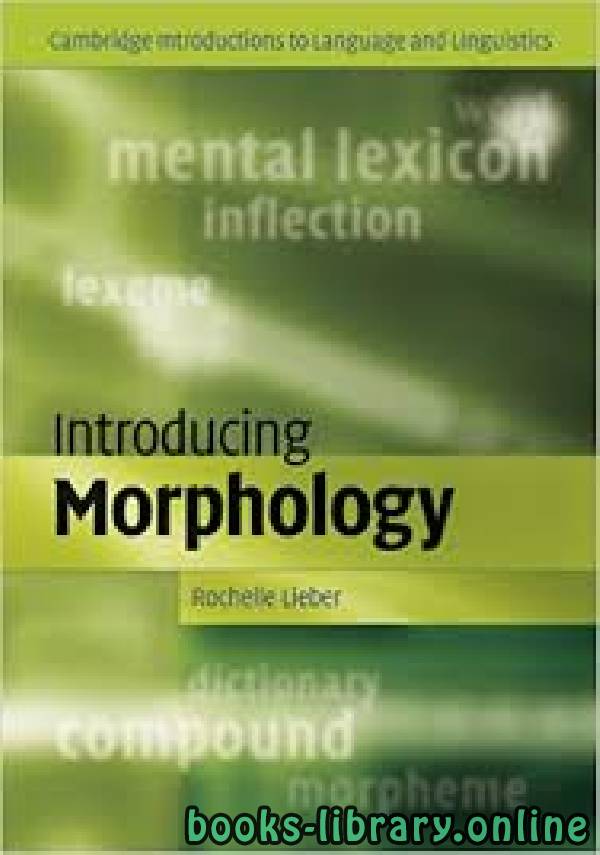📘 قراءة كتاب Introducing Morphology ROCHELLE LIEBER أونلاين

عفواً..
هذا الكتاب
غير متاح للتحميل، حفاظًا على حقوق دار النشر. ،، يمكنكم شراؤه من مصادر أخرى

هذا القسم يحتوي علي كل ما يخص بعلم الصرف
يتوفر علم الصرف على تبيان تأليف الكلمة المفردة بتبيان وزنها وعدد حروفها و حركاتها و ترتيبها، و ما يعرض لذلك من تغيير وحذف، وما في حروفها و حركاتها و ترتيبهما، وما في حروف الكلمة من اصالة و زيادة.
يقتصر مجال دراسات الصرف على الأسماء المتمكنة (المعربة) و الافعال المتصرفة (غير جامدة).
أما الحروف و مبنيات الأسماء و جوامد الافعال، فلا تدخل في مجال دراسته و أبحاثه.
يُعرَفُ الصرف أيضا بعلم التشكل (باللاتينية: Morphologia). والصرف لُغَةً هو التغير والتحويل ومنه تصريف الرياح أي تغيير وجهتها من مكان لآخر.
In linguistics, morphology (/mɔːrˈfɒlədʒi/) is the study of words, how they are formed, and their relationship to other words in the same language. It analyzes the structure of words and parts of words, such as stems, root words, prefixes, and suffixes. Morphology also looks at parts of speech, intonation and stress, and the ways context can change a word's pronunciation and meaning. Morphology differs from morphological typology, which is the classification of languages based on their use of words, and lexicology, which is the study of words and how they make up a language's vocabulary.]
While words, along with clitics, are generally accepted as being the smallest units of syntax, in most languages, if not all, many words can be related to other words by rules that collectively describe the grammar for that language. For example, English speakers recognize that the words dog and dogs are closely related, differentiated only by the plurality morpheme "-s", only found bound to noun phrases. Speakers of English, a fusional language, recognize these relations from their innate knowledge of English's rules of word formation. They infer intuitively that dog is to dogs as cat is to cats; and, in similar fashion, dog is to dog catcher as dish is to dishwasher. By contrast, Classical Chinese has very little morphology, using almost exclusively unbound morphemes ("free" morphemes) and depending on word order to convey meaning. (Most words in modern Standard Chinese ["Mandarin"], however, are compounds and most roots are bound.) These are understood as grammars that represent the morphology of the language. The rules understood by a speaker reflect specific patterns or regularities in the way words are formed from smaller units in the language they are using, and how those smaller units interact in speech. In this way, morphology is the branch of linguistics that studies patterns of word formation within and across languages and attempts to formulate rules that model the knowledge of the speakers of those languages.
Phonological and orthographic modifications between a base word and its origin may be partial to literacy skills. Studies have indicated that the presence of modification in phonology and orthography makes morphologically complex words harder to understand and that the absence of modification between a base word and its origin makes morphologically complex words easier to understand. Morphologically complex words are easier to comprehend when they include a base word.[6]
Polysynthetic languages, such as Chukchi, have words composed of many morphemes. The Chukchi word "təmeyŋəlevtpəγtərkən", for example, meaning "I have a fierce headache", is composed of eight morphemes t-ə-meyŋ-ə-levt-pəγt-ə-rkən that may be glossed. The morphology of such languages allows for each consonant and vowel to be understood as morphemes, while the grammar of the language indicates the usage and understanding of each morpheme.
The discipline that deals specifically with the sound changes occurring within morphemes is morphophonology.
Contents
1 History
2 Fundamental concepts
2.1 Lexemes and word forms
2.1.1 Prosodic word vs. morphological word
2.2 Inflection vs. word formation
2.3 Types of word formation
2.4 Paradigms and morphosyntax
2.5 Allomorphy
2.6 Lexical morphology
3 Models
3.1 Morpheme-based morphology
3.2 Lexeme-based morphology
3.3 Word-based morphology
4 Morphological typology
5 Examples
6 Application
Introducing Morphology
Morphology is the study of how words are put together. A lively
introduction to the subject, this textbook is intended for undergraduates
with relatively little background in linguistics. Providing data from a
wide variety of languages, it includes hands-on activities such as
“Challenge Boxes,” designed to encourage students to gather their own
data and analyze them, work with data on websites, perform simple
experiments, and discuss topics with each other. There is also an
extensive introduction to the terms and concepts necessary for analyzing
words. Topics such as the mental lexicon, derivation, compounding,
inflection, morphological typology, productivity, and the interface of
morphology with syntax and phonology expose students to the whole
scope of the field. Unlike other textbooks it anticipates the question “Is it
a real word?” and tackles it head-on by looking at the distinction between
dictionaries and the mental lexicon.
rochelle lieber is Professor of Linguistics in the English Department at the
University of New Hampshire. Her recent publications include The Oxford
Handbook of Compounding (2009), Morphology and Lexical Semantics (Cambridge,
2004), and The Handbook of Word Formation (2005).
Cambridge Introductions to Language and Linguistics
This new textbook series provides students and their teachers with accessible introductions to the major subjects
encountered within the study of language and linguistics. Assuming no prior knowledge of the subject,
each book is written and designed for ease of use in the classroom or seminar, and is ideal for adoption on a
modular course as the core recommended textbook. Each book offers the ideal introductory material for
each subject, presenting students with an overview of the main topics encountered in their course, and
features a glossary of useful terms, chapter previews and summaries, suggestions for further reading, and
helpful exercises. Each book is accompanied by a supporting website.
Books published in the series
Introducing Phonology David Odden
Introducing Speech and Language Processing John Coleman
Introducing Phonetic Science John Maidment and Michael Ashby
Introducing Second Language Acquisition Muriel Saville-Troike
Introducing English Linguistics Charles F. Meyer
Forthcoming:
Introducing Semantics Nick Riemer
Introducing Psycholinguistics Paul Warren
سنة النشر : 2009م / 1430هـ .
حجم الكتاب عند التحميل : 2.5MB .
نوع الكتاب : pdf.
عداد القراءة:
اذا اعجبك الكتاب فضلاً اضغط على أعجبني و يمكنك تحميله من هنا:
عفواً..
هذا الكتاب
غير متاح للتحميل، حفاظًا على حقوق دار النشر. ،، يمكنكم شراؤه من مصادر أخرى
🛒 شراء " Introducing Morphology ROCHELLE LIEBER " من متاجر إلكترونيّة
شكرًا لمساهمتكم
شكراً لمساهمتكم معنا في الإرتقاء بمستوى المكتبة ، يمكنكم االتبليغ عن اخطاء او سوء اختيار للكتب وتصنيفها ومحتواها ، أو كتاب يُمنع نشره ، او محمي بحقوق طبع ونشر ، فضلاً قم بالتبليغ عن الكتاب المُخالف:
 قبل تحميل الكتاب ..
قبل تحميل الكتاب ..
يجب ان يتوفر لديكم برنامج تشغيل وقراءة ملفات pdf
يمكن تحميلة من هنا 'http://get.adobe.com/reader/'


 منصّة المكتبة
منصّة المكتبة 